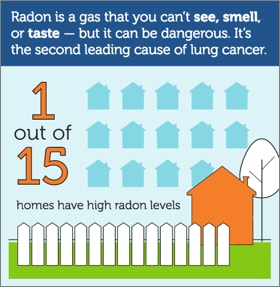
Title:
Subtitle:
Audience: General population

You may already know that smoking is the number one cause of lung cancer in the United States. But do you know what’s number two?
The answer is radon, an invisible, radioactive gas—and if you didn’t know, you’re not alone.
"Radon is a serious public health problem and a lot of people don’t know about it," says Robert Whitcomb, PhD, at the Centers for Disease Control and Prevention in Atlanta, Georgia.
1
But many of the people living in those homes don’t have any idea, Whitcomb says. That’s not surprising, because unlike tobacco smoke, radon isn’t something you can see. You can’t smell or taste it either.
"Testing your home for radon gas is the only way to know if it’s a risk," says Whitcomb. "The good news is that it’s very easy to do."
Did You Know?
- High radon levels can be a risk anywhere in any state. Both old homes and new homes can have radon problems.
- The risks from radon depend on two things:
- How much: High radon levels are more dangerous.
- How long: The more contact you have with radon gas, the greater your risk.
- Testing your home is the only way to find out if you have a radon problem.
- The U.S. Surgeon recommends that all homes be tested for radon gas.
Invisible Invader
Radon gas forms naturally in the ground. Most radon mixes harmlessly with outdoor air, and we all breathe in low levels everyday, Whitcomb says.
The problem is when radon from underground seeps into a home through cracks and gaps in the foundation and gets trapped inside. Breathing indoor air with high radon levels can — over time — damage the lungs and lead to cancer.

Why You Need to Test Your Home
Radon can really be a problem anywhere, Whitcomb says. It can be a risk in small homes and big homes, old homes and new homes.
"You can even have two almost identical houses right next to one another," says Whitcomb. "One will have low radon levels while the other is very high. That’s why everyone needs to test."
You can buy a testing kit online or at your local hardware store for just $10 to $20. You can also order one from the National Radon Program Services website or by calling 1-800-SOS-RADON (1-800-767-7236).
Fixing Radon Problems
"If you find out that you have high radon levels, it can be scary," says Whitcomb. "But addressing the issue is often simpler than homeowners expect."
The key is to work with an expert who can help guide you, Whitcomb says.
1


 ShareCompartir
ShareCompartir


